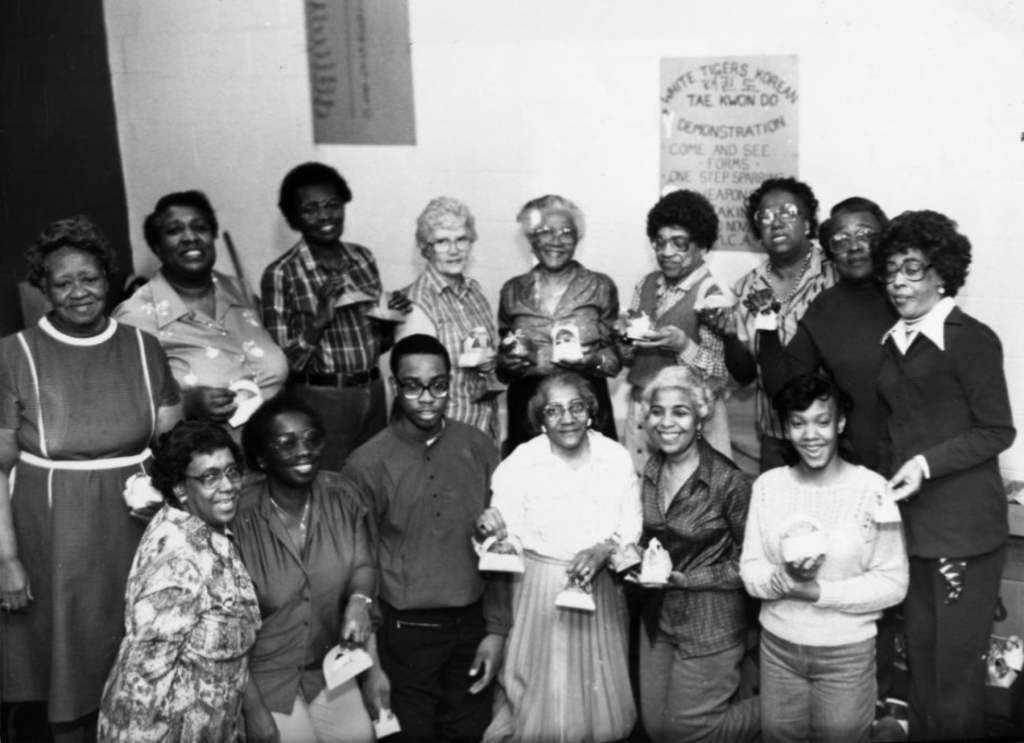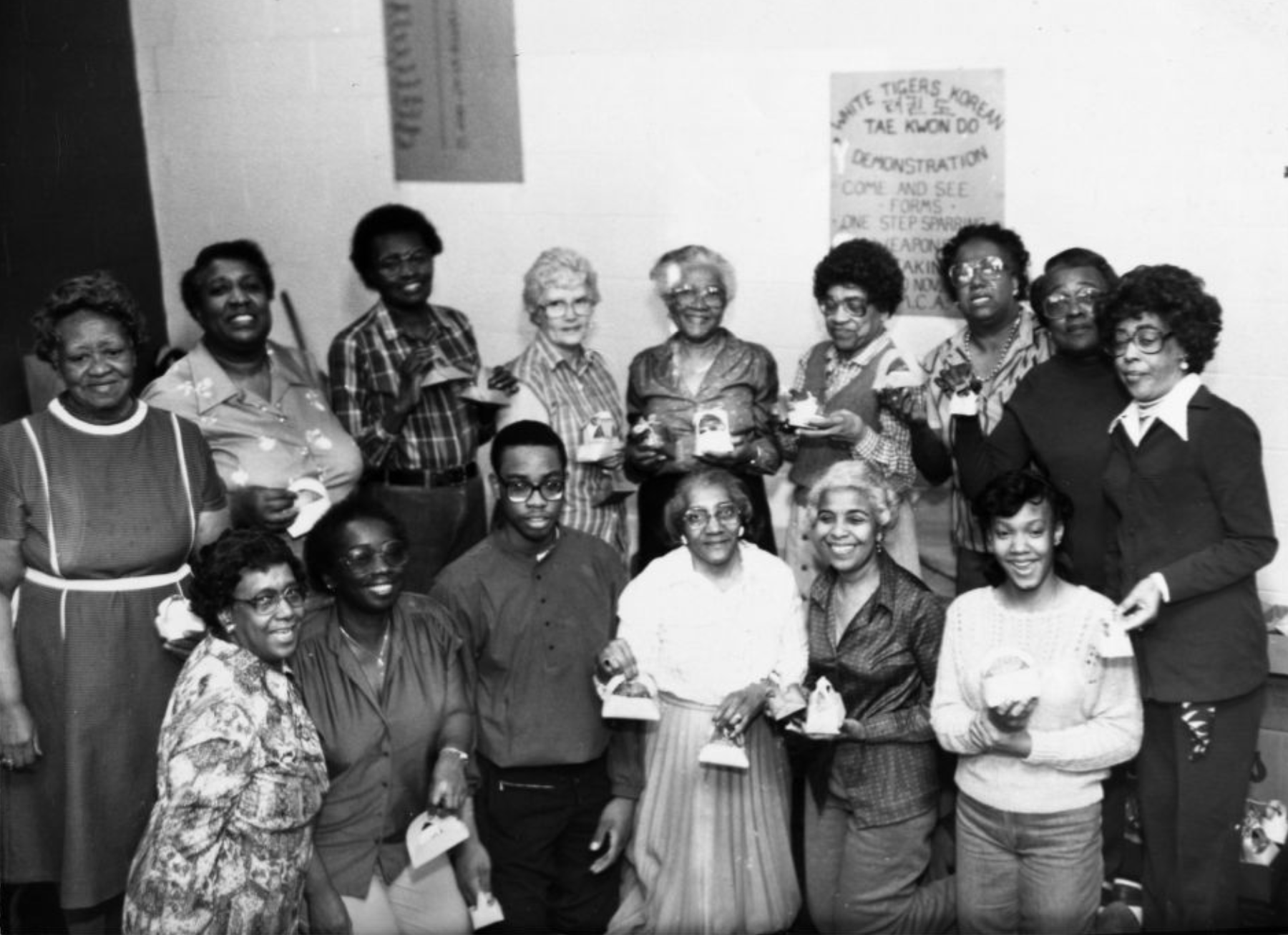As long as there have been churches in Indianapolis, there have been churchwomen involved in religious work. In 1822 an interdenominational group of residents formed the Indianapolis Sabbath School Union; women comprised half the Sabbath School teachers. Although national women’s suffrage was still far in the future, at some early churches, including AME Zion, women members could vote on church matters, which gave them a voice in governing their congregation. In 1898 evangelical churchwomen organized a Missionary Social Union of Indianapolis to help direct and coordinate the activities of women’s church groups. This group joined a national organization of Federated Church Women (now ) in the 1930s, linking local women’s activities with national missionary society movements. Women’s organizations cooked meals for church gatherings and conducted fundraisers. Before 1925 the Ladies Alliance of Corinthian Baptist Church secured enough money through fundraising activity to pay for the construction of a new church building. Countless women also were active in social welfare and social reform initiatives—everything from orphanages to temperance—that were not necessarily sponsored or endorsed by their own congregation but were nonetheless religiously motivated.
These women played an important if unheralded role in the lives of their churches. They provided economic and emotional support for the congregation and its missions but rarely served in congregation-wide leadership roles. Although Indianapolis churchwomen continue to fill support positions, since the 1970s they have also stepped into the arena of church leadership. Today women are pastors of congregations, professors at theological seminaries, and officers of ministerial associations. In Indianapolis, as elsewhere, positions in religious organizations once held exclusively by men are now open to women.
Women in Religious Professions
The number of Indianapolis congregations with women serving as ministers, priests, or rabbis has visibly increased during the past 20 years, although not all denominations accept the practice. In some cases, Indianapolis has had the distinction of being first in the nation in the inclusion of women in nontraditional religious leadership positions.

Rabbi Sandy Eisenberg Sasso was the first woman ordained from the Reconstructionist Rabbinical College. In 1977 she became the first female rabbi in Indianapolis where she and her husband, Rabbi Dennis C. Sasso, served at the congregation. They were the first rabbinical couple in Jewish history. She also was a member of many service organization boards and was co-founder of the Women’s Interfaith Table, which brings together for dialogue Jewish, Catholic, and Protestant women.
National attention was also focused on Indianapolis on January 1, 1977, when Jackie Means became the first woman in the United States to be ordained an Episcopal priest under church regulations. She gained a national reputation for her work in prison ministry in the city and state. The following month Tanya Beck Vonnegut became an Episcopal priest. She was honored as the founding mother of the , which ministers to women through classes, counseling, and therapy groups and sponsors the Sojourner Shelter for abused women.
During the past 20 years the employment of women as religious professionals has become more acceptable to many congregations. The enrollment figures at (CTS) reflect this trend. Their registrar’s report indicates that in 1961 women comprised only 8 percent of the seminary’s students. The percentage of women had doubled ten years later (to 16 percent) and more than doubled during the following decade (to 35 percent by 1981). By the early 1990s over 50 percent of students at CTS were women; there were six women on the teaching staff. Sue Cardwell, the first woman professor at CTS (1979), was also the first woman president of the American Association of Pastoral Counselors and the first from the to be a seminary professor.

Interracial dialogue to create more understanding is a major concern of women, as evidenced by Rev A. H. Byfield, pastor of Robinson Community African Methodist Episcopal (AME) Church. She was the 1991 recipient of the YWCA Phyllis Wheatley Salute Award for working to eliminate racism in Indianapolis, as well as the first Black woman to serve as president of the (IICHE). In 1991 Byfield became the first woman to be elected a member of and to chair the Indiana delegation to the AME National General Assembly and was the first woman elected president of the AME Ministerial Alliance of Indiana.
Catholic sisters have long worked as teachers or hospital staff. Today, excluding the priesthood, there are few limits to the options open to them. Sister (Sr.) Theresa Mount was the first sister appointed as rector of St. Maur’s when it was a seminary for Catholic men. Sr. Jane Bodine, a finance expert with support from educated religious communities in Indianapolis and across the nation about development and stewardship. Sr. Nancy Crowder opened and operated the city’s first facility for the homeless—the Holy Family Shelter. Sr. Loretta Schafer became the first woman chancellor of the Indianapolis Archdiocese and was among the first women in the United States to serve in that capacity.
Laywomen in Staff or Volunteer Religious Positions
During the past 30 years, the leadership positions in most religious bodies have gradually included laywomen in positions traditionally held by laymen.
Valerie Dillon was the first Catholic laywoman to be a director in the Indianapolis Archdiocese, serving as Director of Family Life (1982-1991). She was also the first woman to serve as acting editor of the and as president of the Professional Association of Catholic National Family Life Ministries. Indianapolis Archdiocese Chancellor, Susan Magnant, was the first lay-woman in this position. Ellen Healey, the first woman president of the Archdiocese, also chaired an historic Women’s Consultation to give Catholic women the opportunity to express their feelings, positive and negative, about the church.

Other laywomen have served as volunteer leaders to respond to social concerns. For instance, Birdie Whiteside mobilized women volunteers from inner-city and suburban churches of many denominations to help with the Guiding Light Christian Service, started in 1953 as a project to minister to shut-ins, nursing home residents, and prison inmates. Churchwomen were also instrumental in beginning adult day care centers and in creating food pantries, including the . Other changes include a new role for the clergy spouse. Formerly always female, she was considered hired without pay to work for the church along with her husband. Now the spouse may be a husband and the majority are employed, sometimes in religious vocations or volunteerism beyond their own congregation. United Methodist Dorothea Green, for example, was the first woman president (1975-1977) of the Indianapolis-based Indiana Council of Churches (ICC) and the first woman director of the IICHE.
Women’s religious work in Indianapolis began with service as Sunday School teachers and has progressed through a wide variety of other support activities (meal preparation, fundraising) to full-time ministerial positions. Mirroring and sometimes leading the national experience of churchwomen, Indianapolis has been and continues to be fertile soil for women in religious work.
*Note: This entry is from the original print edition of the Encyclopedia of Indianapolis (1994). We are currently seeking an individual with knowledge of this topic to update this entry.

Help improve this entry
Contribute information, offer corrections, suggest images.
You can also recommend new entries related to this topic.


